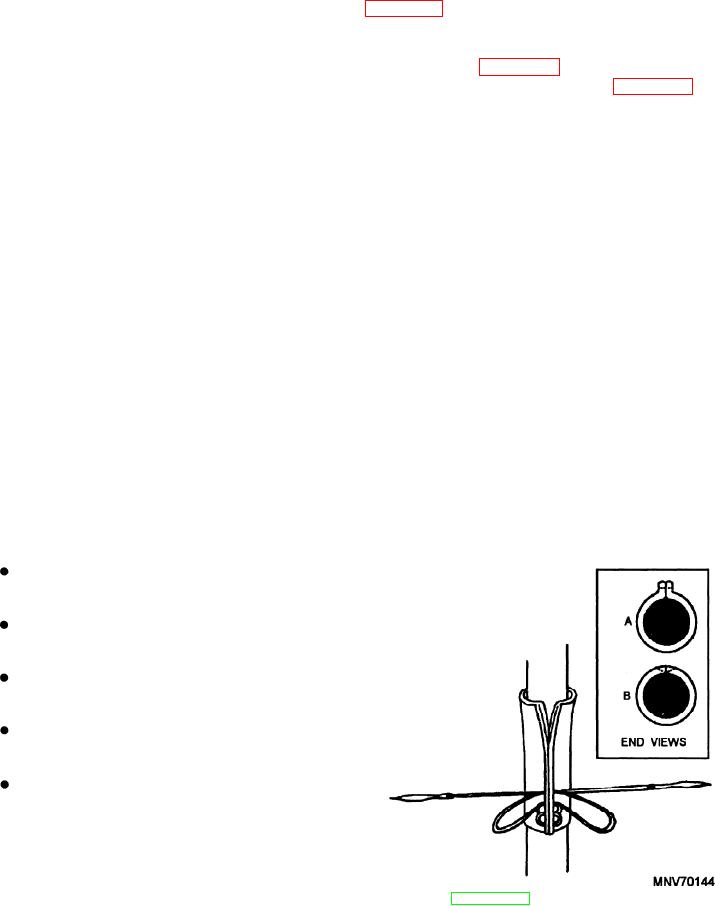
Belting is either round or flat and is issued in any
run to countersink the stitches below the surface. Draw
a line parallel and close to the edge first, then make your
desired length by the linear foot. Round belting comes
groove with a grooving tool (a dull knife will do). Use a
in two widths: one-fourth inch and three-eighths inch.
block of wood for a straightedge. Next, punch holes
Width is used instead of diameter because, despite the
along the grooves for the stitches.
name, round belting is oval rather than perfectly round.
Flat belting may be either single- or double-ply. Single-
The shoemaker's or cobbler's stitch is shown in
ply belting is available in 1- to 6-inch widths; double-
figure 5-20. A variation of this stitch is to cut the leather
ply, in 2- to 12-inch widths.
carefully so that the edges abut. Angle the grooves
toward the edges of the leather and sew through the
The most common types of artificial leathers are
edges. Inset A of figure 5-20 shows the end view of the
used for upholstery and are issued by the square foot.
regular shoemaker's stitch. Inset B of figure 5-20 shows
the variation.
CARE OF LEATHER
For easier handling of leather, soak it in a bucket of
Leather exposed to the elements should be kept well
water for a few minutes. This will soften the leather and
oiled or waxed. Any oil that does not contain harsh
make it easier to form.
chemicals is suitable, but the best is neat's-foot oil.
Leather in places such as on lifelines may be kept well
UNDERWAY REPLENISHMENT
preserved by the application of paste wax. Saddle soap,
an excellent preservative and cleaner, can be used on
Underway replenishment (UNREP) is a broad term
holsters, shoes, jackets, and other leather wearing
applied to all methods of transferring fuel, munitions,
apparel. If leather becomes badly soiled and stained,
supplies, and personnel from one vessel to another
wash it with a mild soap and water solution, rinse it well,
while under way. The term replenishment at sea,
and then dry it in a spot away from intense heat. After it
formerly used in this sense, now applies to all methods
is dry, apply saddle soap or neat's-foot oil to replace the
except those for fueling at sea.
natural oils of the leather.
Before the techniques of UNREP were developed, a
Leather is especially subject to mildew and rotting.
ship that ran low on fuel, supplies, or ammunition had to
It is also highly susceptible to accidental cutting,
return to port, or the fleet had to lie to while the ship was
gouging, and abrading. Excessive heat causes it to
partially replenished by small boats. If several or all of
shrink considerably, with subsequent rending and
cracking. Acids, corrosives, or their fumes have a
the ships were in need, the whole fleet had to return to
disastrous effect upon leather.
port. The disadvantages were obvious. The
To avoid the problems mentioned above when you
effectiveness of a fleet was reduced by every ship that
stow leather, follow the suggestions listed below.
had to leave, and a ship or small group of ships detached
Stow rolls of leather on top of other materials to
prevent crushing
Stow leather well clear of any liquids or greases
that might stain it
To prevent hides stowed one on top of the other
from sticking, place paper between the hides
Leave original, moistureproof wrappers on as
long as possible, to prevent mildew
Be sure the compartment in which you store the
leather is dry and well-ventilated.
SEWING LEATHER
When you need to join two leather edges by hand-
sewing, groove the lines along which the stitches will
Figure 5-20.--Shoemaker's stitch.
5-12

